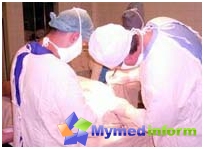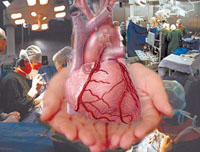Phlegmon is a spilled purulent inflammation that does not have clear boundaries. The main clinical manifestations of the disease are painful swelling, spilled redness of the skin, high temperature. Phlegmor treatment conservative and is carried out only in the hospital.
Content
Concept of phlegmon
 Phlegmon is a sharp purulent spilled inflammation of the cellulum spaces (subcutaneous, intermushkin, trachinhal, etc.). In contrast to abscess, the process does not have clear boundaries. The causative agents are usually staphylococci and streptococci, but can be caused by other gloty microbes that penetrate into fiber through random damage to the skin, mucous membranes or hematogenic means. Phlegmon can also be caused by the introduction of various chemicals under the skin (turpentine, kerosene, gasoline, etc.). It is an independent disease, but may also be a complication of various purulent processes (carbuncoon, abscess, sepsis, etc.). Inflammatory exudate applies to fiber, moving from one fascial case to another through holes for vascular-nerve beams. Spreading the fabrics, squeezing and destroying the vessels, pus leads to necrosis of fabrics.
Phlegmon is a sharp purulent spilled inflammation of the cellulum spaces (subcutaneous, intermushkin, trachinhal, etc.). In contrast to abscess, the process does not have clear boundaries. The causative agents are usually staphylococci and streptococci, but can be caused by other gloty microbes that penetrate into fiber through random damage to the skin, mucous membranes or hematogenic means. Phlegmon can also be caused by the introduction of various chemicals under the skin (turpentine, kerosene, gasoline, etc.). It is an independent disease, but may also be a complication of various purulent processes (carbuncoon, abscess, sepsis, etc.). Inflammatory exudate applies to fiber, moving from one fascial case to another through holes for vascular-nerve beams. Spreading the fabrics, squeezing and destroying the vessels, pus leads to necrosis of fabrics.
By the nature of the exudate, the following forms of phlegmon are distinguished:
- serous
- purulent
- purulent hemorrhagic
- Snimmer
Row of localization phlegmons wears special names. Thus, the inflammation of the octoral fiber is called paranefrit, the near-cell fiber - paraproititis, etc. Most often subcutaneous fiber is inflamed, which is associated with its weak resistance to infection and frequent injuries.
The main manifestations of the disease
Characterized by the rapid appearance and propagation of painful swelling, spilled redness of the skin over it, with high temperatures (40°C and higher), pools, impaired function of the affected body. Next, swelling turns into a dense infiltration, which then softens and appears a symptom of fluctuations. FLEGMONES is usually heavy. Malignant for the course of the form are often found when the process is rapidly progressing, exciting extensive areas of subcutaneous, intermuscular fiber and is accompanied by severe intoxication.
In the secondary development of phlegmon (osteomyelitis, purulent arthritis, purulent pleurisy, peritonitis, etc.) It is necessary to identify the main disease. Phlegmon, which arises primary, can cause the development of a number of complications (lymphadenitis, lymphangit, mug, thrombophlebitis, sepsis, etc.). The distribution of the process to the surrounding tissues leads to the development of purulent arthritis, tendovaginitis and other purulent diseases. Flegmon Faces may complicate the progressive thrombophlebitis of veins of the face and purulent meningitis.
Phlegm treatment
Patients with phlegmon are necessarily hospitalized. At the beginning of the disease, there is permissible conservative treatment: the bedding is assigned, it is ensured by peace for the sore limb, the larger doses of antibiotics are introduced intramuscularly, abundant drinking, milk-vegetable diet, heartfall, painful. Fabrics in the circumference of phlegmon are peeling with a solution of antibiotics in Novocaina, locally dry heat, UHF. The process may stop: to form an abscess or limited phlegmon. Treatment ends with opening and drainage. With progressive phlegmon, the deferment of operational intervention is unacceptable. If there is no improvement after surgery and overall treatment, it is necessary to offer the presence of a local or general complication (further progression of phlegmon, thrombophlebitis, mug, purulent chapels, septic state). With severe condition due to the threat to the patient's life, it may be necessary to amputate the limb.









